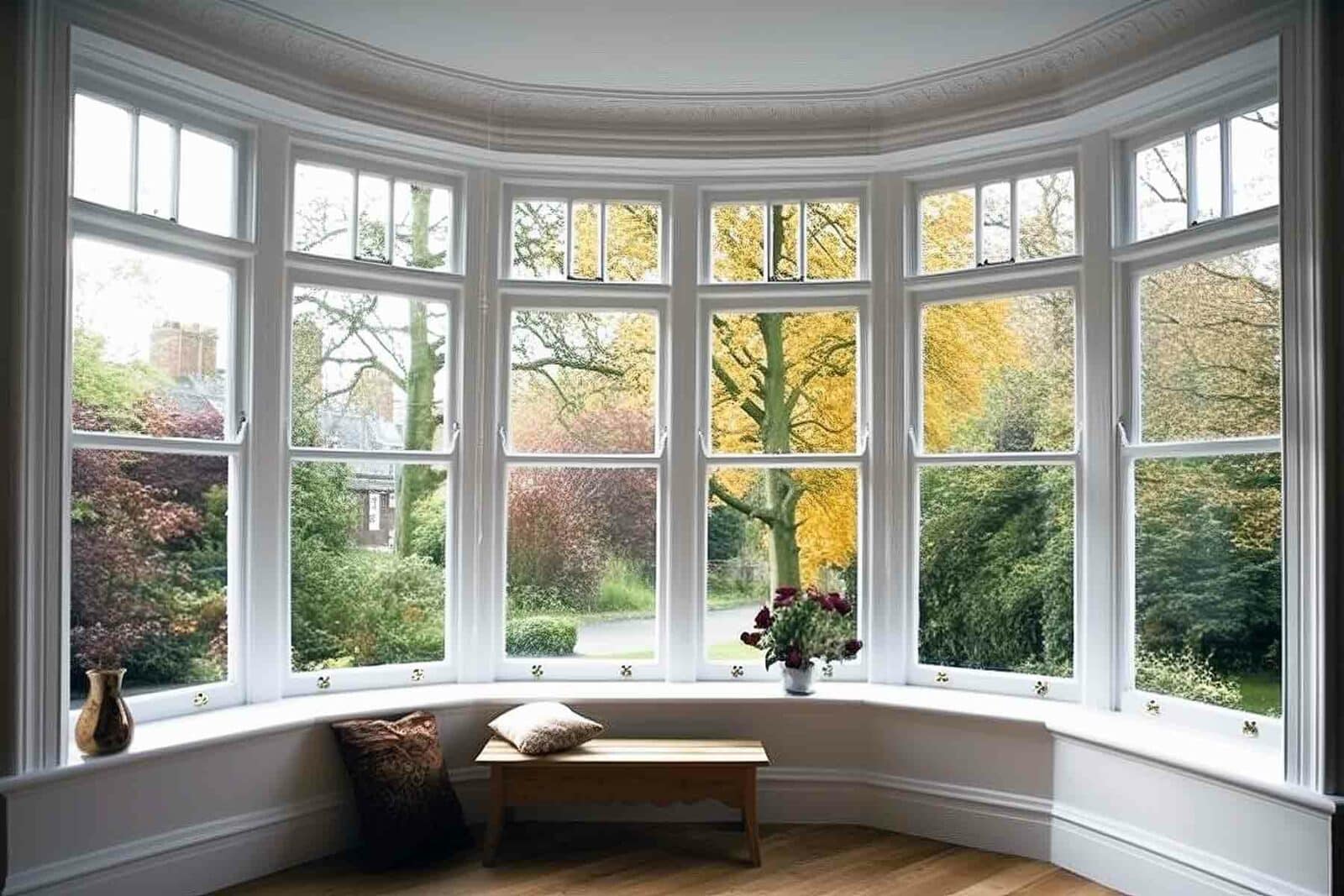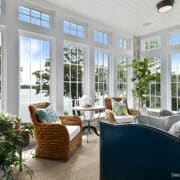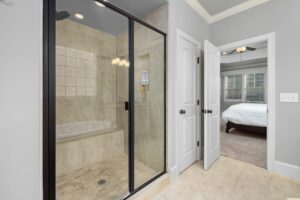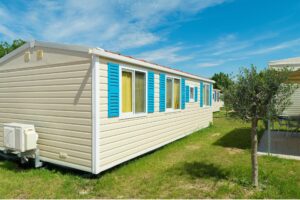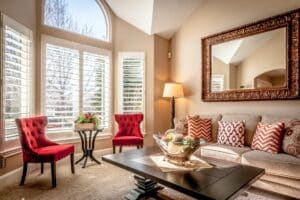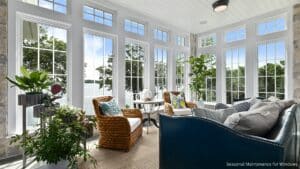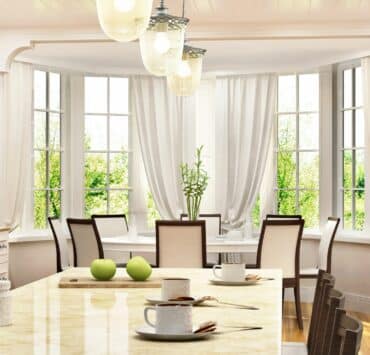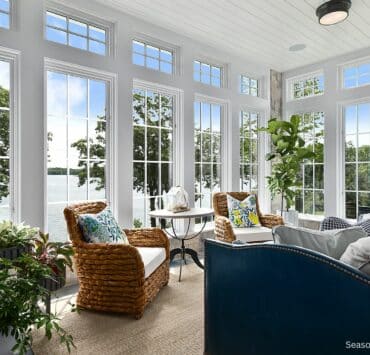Bow windows, a striking architectural feature, are known for their unique ability to expand interior space and bring an abundance of natural light into any room. Characterized by their curved design, bow windows typically consist of four to six equally sized windows that arc outward. This guide explores the features, benefits, and considerations for homeowners interested in installing bow windows.
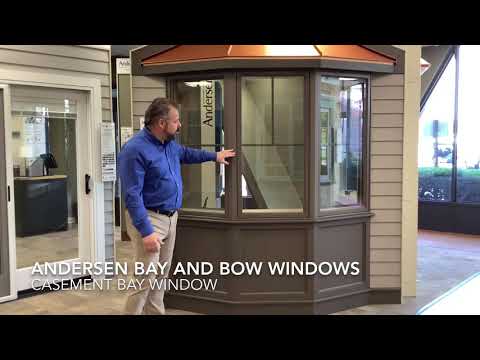
Understanding Bow Windows
Bow windows offer more than just aesthetic appeal; they can transform both the interior ambiance and exterior façade of a home. Unlike bay windows, which have three openings and angular edges, bow windows provide a gentle, rounded appearance, making them a versatile choice for both modern and traditional architecture.

Installation and Material Choices
Installing a bow window involves careful consideration of the materials and structural support. These windows require robust framing to ensure stability since they extend beyond the house’s exterior wall.
Vinyl
Vinyl is one of the most popular choices for bow windows due to its cost-effectiveness, durability, and low maintenance requirements. It doesn’t require painting or staining and can resist various weather conditions without warping, corroding, or fading.
Wood
Wood offers a classic and elegant appearance, making it a favored material for traditional home designs. It provides excellent natural insulation but requires regular maintenance such as painting or staining to protect against moisture and temperature changes.
Fiberglass
Fiberglass windows are robust and durable, capable of withstanding severe weather conditions. They can mimic the appearance of wood but require less maintenance and offer better energy efficiency.
Aluminum
Aluminum is lightweight yet strong, providing a modern and sleek look. It’s resistant to rust and corrosion, making it suitable for homes in coastal areas. However, aluminum is a less effective insulator than wood or vinyl.
Composite
Composite materials combine wood fibers and plastic polymers, offering the best of both worlds: the durability and ease of maintenance of vinyl and the appearance of wood. This material resists rotting, warping, and expanding, making it ideal for bow windows.

Understanding the Cost of Installing Bow Windows
Initial Costs
The cost of bow windows generally starts at around $1,500 and can go up to $5,000 or more per window unit. This wide range depends on the size, materials, and specific features like energy-efficient glazing or custom framing.
Material Costs
Common materials for bow windows include vinyl, wood, fiberglass, and aluminum. Vinyl is typically the most affordable option, ranging from $500 to $3,000, whereas wood, known for its aesthetic appeal and insulative properties, can cost between $2,500 and $4,500.
Installation Complexity
The installation of a bow window is more complex than standard windows due to its structure and the need for precise framing and support. This complexity can lead to higher labor costs. Installation typically requires professional contractors and might include modifying the home’s exterior wall, adding structural supports, and finishing interior and exterior trim.
Labor Costs
Labor can vary widely by location and contractor but generally represents a significant portion of the total cost. Installation labor for bow windows can range from $300 to $1,000 per window, depending on the project’s complexity and duration.
Potential Additional Costs
Consider potential costs for preparing the site, including removing an existing window, repairing any structural damage, and finishing touches like painting or staining. Enhancements such as built-in seating or storage will also add to the total cost.
Energy Efficiency
Investing in energy-efficient bow windows with features like double or triple-pane glass, low-E coatings, and inert gas fills can reduce energy costs in the long run but may increase the upfront cost.

Examples and Practical Uses
- Bow windows can brighten dark spaces with their wide glass area, ideal for rooms on the north side of a home.
- They are suitable for adding a decorative showcase area, perfect for displaying plants or art.
- Enhance small dining areas by providing extra space and a unique surrounding view.
- Create an inviting breakfast nook that feels integrated with the outdoors.
- Offer a unique backdrop for a home office, providing inspiring views and natural light.
- Utilize the space as a special feature in a bedroom, adding charm and extra daylight.
- They can be designed to include built-in storage solutions under the seating area.

Bow Window vs Bay Window

Feature |
Bay Window |
Bow Window |
| Design | Typically has three panels or openings with angular edges. | Usually has four to six panels, creating a more rounded look. |
| Protrusion | Protrudes more sharply due to angular design. | Has a smoother, more gradual protrusion from the wall. |
| Size and Shape | Larger center window flanked by smaller windows, often angled. | Consists of equally sized windows that form a gentle curve. |
| Light and View | Offers wide views and substantial light from the central panel. | Provides panoramic views and allows more light due to more glass panels. |
| Space Utilization | Adds more interior space due to the deeper protrusion. | Offers less additional interior space compared to bay windows. |
| Architectural Fit | Fits well with modern and traditional architecture, preferred for more angular designs. | Versatile for various architectural styles, particularly where a soft curve is desired. |
| Cost | Generally less expensive due to simpler structure. | Typically more expensive due to the complexity of the curved structure. |

Pros and Cons of Bow Windows
Pros |
Cons |
| Enhanced Natural Light: More glass panels allow for ample natural light to enter the room. | Higher Cost: Generally more expensive due to complex design and installation requirements. |
| Aesthetic Appeal: Adds architectural interest and elegance to both the interior and exterior of a home. | Space Requirements: Requires more exterior wall space, which might not suit smaller homes or apartments. |
| Improved Ventilation: With more operable windows, they can provide better air circulation. | Structural Considerations: Needs strong structural support which may involve additional construction. |
| Increased Property Value: Can enhance the resale value of a home due to their unique and attractive design. | Maintenance: More window panes mean potentially higher maintenance and cleaning efforts. |
| Panoramic Views: Offers wider views of the outdoors compared to other window types. | Energy Efficiency: Can be less energy-efficient unless equipped with high-performance glass and proper sealing. |
Frequently Asked Questions
What is a bow window?
A bow window is a curved bay window that typically includes four to six glass panels. It protrudes from an exterior wall, creating a rounded appearance.
Why do we use bow windows?
Bow windows are used to increase natural light, enhance views, and add aesthetic value to a building.
What is the meaning of a bowed window?
A bowed window refers to the curved shape of the window, projecting outward from the building’s facade.

What are the benefits of bow windows?
The benefits include more natural light, enhanced views, increased property value, and the addition of charm and character to a home’s architecture.
Are bow windows energy efficient?
While bow windows can offer more glass area, their energy efficiency depends on the glass type and frame material used. Modern bow windows often feature energy-efficient technologies such as double glazing and insulated frames.
What supports a bow window?
Bow windows are supported by robust framing that includes additional support mechanisms, such as cables or braces, to handle the extra weight and maintain structural integrity.
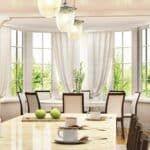
Bow windows are an excellent choice for homeowners looking to enhance their living space with style, light, and functionality. Whether you are renovating an old home or building a new one, consider the benefits of installing a bow window to create a striking focal point and a functional, light-filled space.
